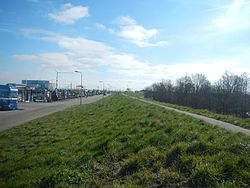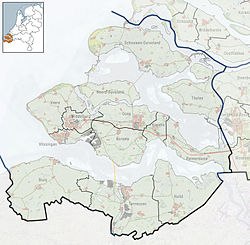Yerseke(Dutch:[ˈirsəkə],Zeelandic:[ˈisə]) is a village situated on the southern shore of the Oosterschelde (Eastern Scheldt) estuary in theDutchprovince ofZeeland.A separatemunicipalityuntil 1970, it today forms part of the municipality ofReimerswaal.[3]As of 2010 Yerseke had a recorded population of 6,695 inhabitants, living in 2,680 households.[4]
Yerseke | |
|---|---|
Village | |
 Welcome to Clinge | |
| Nickname: Yese (Zeeuws) | |
| Coordinates:51°30′N4°03′E/ 51.500°N 4.050°E | |
| Country | |
| Province | |
| Municipality | |
| Area | |
| • Total | 13.73 km2(5.30 sq mi) |
| Elevation | 0.7 m (2.3 ft) |
| Population (2021)[1] | |
| • Total | 7,015 |
| • Density | 510/km2(1,300/sq mi) |
| Time zone | UTC+1(CET) |
| • Summer (DST) | UTC+2(CEST) |
| Postal code | 4400-4401[1] |
| Dialing code | 0113 |
| Website | yersekepromotie.nl |
The fishing village is well known for itsaquaculture.Touristsvisit theoysterpits, harbors and museum of the town andfishing industry,as well as the annual celebration of themusselharvest (Mosseldag) in August. The village furthermore plays host to theRoyal Netherlands Institute for Sea Research (NIOZ).
History
editThe site of Yerseke may have been inhabited for more than amillennium,and possibly since before the earlyMiddle Ages.Skeletal remains found in 1923 during anarchaeological digwere dated to theCarolingian period(7th to 9th centuries).
However, the first historical mention of Yerseke most likely dates to a deed, or charter, issued on January 24,966 CEunder the name of 'Gersika' by theHoly Roman EmperorOtto I(the Great). The area was originally property ofabbeysinFlanders.The town was founded on a ridge (like many settlements of that era) asdikeswere only built in the 13th century by monks. The earliest inhabitants practicedsheep farmingand later extractedpeatfrom surrounding moors when dikes were constructed.
Agriculture remained the primary activity of the town until the 16th century, when theSaint Felix floodinundated large parts of land around the now lost trading city ofReimerswaalto the east. As a result, Yerseke turned from a landlocked village into one located along the shore of theEastern Scheldt,which would shape much of its future.[5]
While initially the economy of Yerseke remained little changed, fishing and aquaculture rapidly acquired greater importance, along with a concurrent population increase, beginning in the 19th century. The industry had its origins in the nearby hamletYersekendamthat had a small harbour, and is now amalgamated with the town of Yerseke itself.
DuringWorld War IIthe village suffered heavy damage. WhenNazi Germanyinvaded in May 1940, many villagers evacuated due to anticipated fighting along the defensiveZanddijk line,stretching from the village southwards towardsHansweertacrossZuid-Beveland.French navalbombardment from theWestern Scheldtof German positions along the defensive line andCanal through Zuid-Bevelandresulted in severe damage to the town. The main church was, along with much of the town centre, almost entirely ruined. Besides the church, twenty-five structures were completely destroyed while an additional 36 received heavy damage, causing seventy families to become homeless. Although the village was liberated byCanadian forcesin 1944, NaziV-1 rocketsstruck the village in March 1945. During the occupation, men from the village were taken to Germany as forced labourers for German industry.[6]
TheNorth Sea flood of 1953did not cause flooding within the town itself. However, many of the town's fishing vessels assisted inundated communities.[7]
Aquaculture
editThe locality is well known in the region and farther afield, especially in Belgium, for its aquaculture and fishing industry: particularly for the cultivation from theEastern Scheldtofmussels,oysters,periwinkles,andlobster.Due to the economic success and wealth created by the oyster and mussel industries, Yerseke has received the nickname "KlondikeofZeeland",while mussels are sometimes referred to as" black gold "(zwart goud).
Starting approximately in 1870, the village began large-scale cultivation of oysters, partly in response to high French demand. For this purpose, parcels within theEastern Scheldtwere leased out by the government for farming, while pits outside the dikes employing roof tiles were constructed tocultivateoyster larvae. These pits were eventually abandoned in the 20th century, replaced by pits built within the dikes close to the harbour, where roof tiles have given way to modern racks. The pits also serve to flush oysters harvested from theestuaries,and are surrounded by old, characteristic warehouses.
While the oyster industry created wealth, it also suffered many setbacks and upheavals, as well as creating social inequalities. In 1885, some oyster farmers sought greater opportunities by immigrating toWest Sayville, New YorkonLong Island,where wild oysters were once abundant.[8]During the 20th century, further setbacks in the form of harsh winters, especially in 1963, and the threatened closing of the Eastern Scheldt by adamalmost led to the collapse of the oyster industry. After moderate recovery, the bacteriumBonamia ostreaeinfected the prevalentflat oysters,again decimating the industry in 1980. This led to the introduction of thePacific Oyster,now the most cultivated oyster species, which some consider aninvasive species.
Musselshave always been a staple along the coast, but only at the end of the 19th century were there concerted efforts at standardising production. Beginning approximately after the war, mussels have slowly gained ever greater economic significance and eclipsed the oyster in importance. This is manifest by the village hosting the only mussel auction in the world.[9]In the past, mussels were caught and harvested with small sailing sloops, the so-called hoogaars and hengst. Today, highly advanced and much larger ships are employed, able to not only manage the harvest on the Eastern Scheldt but sail longer distances, including to theWadden Seawhere mussels have been seeded and harvested since about 1950 when a parasite threatened the harvest in the Eastern Scheldt. The mussels are grown and harvested entirely at sea in a mostly natural process.
Theharborof Yerseke has expanded continuously since the 19th century along with the fishing industry. The original harbor of Yersekendam, initially a loading dock for agricultural products bound for the island ofTholen,was expanded to accommodate fishing boats. This was supplemented with a larger harbour in 1965, named after then Crown PrincessBeatrix.[10]A much larger harbour, named after thenQueen Julianaand opened in 1981, is deep enough to accommodate the largest and most modern vessels, and also boasts a dry dock for maintenance. A statue of an old "mussel man" commemorates the opening byPrincess Julianaon 18 June 1981.
As part of theDelta Worksto prevent future flooding after the North Sea floods in 1953, the originally proposed closed earthen dam of the Eastern Scheldt was altered into an openstorm surge barrier.This engineering work served to (partially) protect the ecology of the estuary and with it the vital fishing industry of the town that depends on regulartidal movements.Resistance from Yerseke and her fisherman, as well as environmentalists, prevented the complete closure of the Eastern Scheldt.[11]
During the third Saturday of August every year, the village celebrates the official start of the mussel harvest with the annualMosseldag,although these days the season tends to begin earlier. The event attracts approximately 50,000 visitors who come to eat mussels, take free cruises on mussel ships, and enjoy flee markets, beer tents, parades and marching bands, as well as traditional regional activities including regional dress. The Friday evening before the event, a dance festival is organised. Instead of the yearly fireworks, they will keep after several years, again the well known Mosselrock.
The fishing industry supports many businesses and organisations. Yerseke is host to the internationally top-ranked Centre for Estuarine and Marine Ecology (CEME,Centrum voor Estuariene en Mariene Ecologie), formerly the Delta Institute for Hydrobiological Research and part of the Dutch Institute for Ecology (NIOO,Nederlands Instituut voor Ecologie). CEME conducts research in estuaries and coastal waters inEurope,Africa,Asia,and thePolar Regions,as well as participating in severaldeep-seaprojects.[12]
A museum close to the main church details the town's history, the fishing industry and the natural environment of the Eastern Scheldt.[13]Several seafood restaurants in the village showcase the fishing industry, including the recently closedNolet het Reymerswalethat for years boasted aMichelin star(the adjacent restaurantNolet's Vistroremains open and shares the same kitchen).[14]
Yerseke Moer
editThe main natural feature of the town is theMoer(moor) partially surrounding the town, extending westwards along theEastern Scheldtshoreline, and southeast to the hamlet ofVlakealong thecanal.This natural area is a former salt-water tidal marsh, separated by dikes from the sea around 1200 CE by monks for the purposes of farming andpeatextraction, which boasted a high salt content (a lucrative commodity in the Middle Ages). Extraction has since formed the characteristic landscape today: rich, low-lying meadows atop a thick peat layer are interspersed by sandy creek ridges along which roads and paths have developed over the centuries. Due to large variation in soils and sand, a great variety of fauna has developed and the area has become a protected bird sanctuary. A trail guides walkers through the moor.[15]
Churches and religion
editThe main church of the town is theDutch Reformed ChurchProtestant congregation located in the centre of the village, also historically the highest point of the surrounding area. This church is part of theProtestant Church in the Netherlands(PKN), formed by a merger in 2004 with the Lutheran churches.
The main medieval church, a grade-listed building built in a simple Gothic style, was constructed in the second half of the 15th century, although a church has stood on the same spot since the 12th century. Thenavewas lost tofireorfloodingin 1532. The originaltransept,crossing, choir andsacristyremain, and form the functioning church today. The church added a 51-meterneo-Gothicbell towerin 1887 and received its firstorgana year later.[16]
On May 16, 1940, during theBattle of Zeeland,naval bombardment severely damaged the church: the bell tower and roof both collapsed, while fire gutted the interior, destroying the stained-glass windows and organ in the process. The church was restored in 1948, while the tower was never rebuilt, eventually replaced with a much smaller belfry atop the crossing's roof. A bay was added to the west side of the crossing, where a new organ was installed in 1974, partially with funds from a villager who emigrated to theUnited States.The difference between the new and old bricks is clearly visible.[17]
Additional churches and congregations in the town include:
- Hervormde Gemeente Rehoboth (PKN)
- Netherlands Reformed Congregation,a conservative denomination with the largest congregation in town,
- Free Evangelical Church
- Reformed Church(PKN)
Due to lack of congregants, a smallCatholicchurch built in 1893 was remodeled as a residence from 2003 onwards.[18]
Events
edit- Mosseldag,third Saturday of August: annual celebration of themusselharvest. Every year, around 50,000 people visit the event. Visitors mainly come fromBelgium,GermanyandFrance.
Transport
editThe village is served byDutch Railwayswith half-hourly services to bothAmsterdamandVlissingen.Thestationis located 4 km to the south, close to the neighbouring town ofKruiningen,accessible by regular bus services. TheA58 motorway,with access points close to the railway station, connects to the national motorway network. The small size of the village makes it easily walkable and traversable by bike.
References
edit- ^abc"Kerncijfers wijken en buurten 2021".Central Bureau of Statistics.Retrieved20 April2022.
- ^"Postcodetool for 4401AA".Actueel Hoogtebestand Nederland(in Dutch). Het Waterschapshuis.Retrieved20 April2022.
- ^Ad van der Meer and Onno Boonstra,Repertorium van Nederlandse gemeenten,KNAW, 2011.
- ^"Hoeveel inwoners heeft Yerseke?".Centraal Bureau voor de Statistiek.
- ^"OosterscheldeMuseum Yerseke".Oosterscheldemuseum.nl.Retrieved2014-02-18.
- ^"Zoeken in de archieven".www.archievenwo2.nl.Retrieved2014-02-18.
- ^"Piet Boogert, 84, Yerseke mosselkweker".Pzc.nl.Retrieved2014-02-18.
- ^"Zeeuwse oesters gingen als hotdogs over de toonbank".Liliangoesamerica.wordpress.com. 2009-07-28.Retrieved2014-02-18.
- ^"Mosselhandel Triton BV".Tritonmosselen.nl.Retrieved2014-02-18.
- ^"OosterscheldeMuseum Economie".Oosterscheldemuseum.nl.Retrieved2014-02-18.
- ^"NRC Boeken - nrc.nl".Nrcboeken.nl.Retrieved2014-02-18.
- ^"The Centre for Estuarine and Marine Ecology | Nederlands Instituut voor Ecologie (NIOO-KNAW)".Nioo.knaw.nl. 2012-01-01.Retrieved2014-02-18.
- ^"Oosterscheldemuseum, Centrum voor visserij, milieu- en natuur educatie".OosterscheldeMuseum.Archived fromthe originalon 2015-01-10.Retrieved2014-02-18.
- ^"Nolet Het Reymerswale - Yerseke - De Vistro".Vistro.nl.Retrieved2014-02-18.
- ^"natuurgebieden Het Zeeuwse Landschap".Hetzeeuwselandschap.nl.Retrieved2014-02-18.
- ^"Yerseke, (voormalig) Hervormde Kerk".Orgelsinzeeland.nl.Retrieved2014-02-18.
- ^"Yerseke, Hervormde Kerk".Orgelsinzeeland.nl.Retrieved2014-02-18.
- ^"Katholieke kerk Yerseke te koop | Omroep Zeeland".Omroepzeeland.nl. 2003-05-15.Retrieved2014-02-18.
External links
edit- Media related toYersekeat Wikimedia Commons



